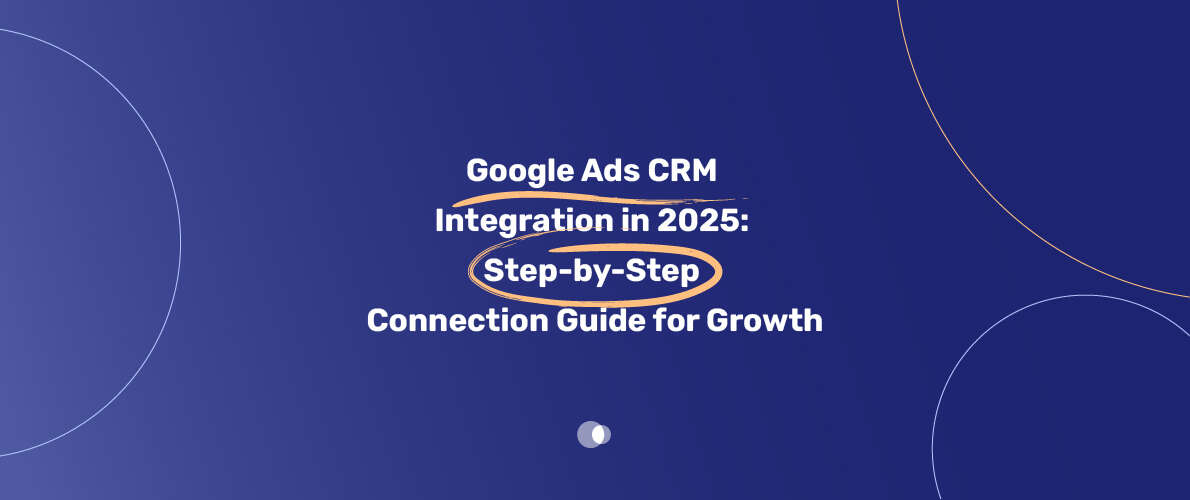AdWords company in Dubai—that’s how I got my start in digital marketing, and let me tell you, a lot has changed. But one thing hasn’t: the absolute power of your data. If there’s a single “hack” for thriving in 2025’s hyper-competitive ad landscape, it’s this: connect your CRM to Google Ads. That’s what we call Google Ads CRM Integration in 2025, and, trust me, it’s how you move from guesswork to growth.
Table of Contents
Today, I’m breaking it all down. You’ll get the step-by-step, no-nonsense guide to integrating your CRM—whether that’s HubSpot, Salesforce, or something custom—with Google Ads. And I’ll be honest: I’ve seen businesses go from burning cash to printing it, just by making this leap. Whether your budget is tight and you’re thinking “maybe Zapier?” or you run an enterprise with a dev team itching for API work, I’ll walk you through every viable path. Ready? Let’s get into it.
Why Google Ads CRM Integration in 2025 is a Game Changer
Alright, picture this: You’re running killer search ads, leads are rolling in, but… you can’t tell which ones turn into sales. Or worse, your sales team is chasing every lead, and half of them are duds. Sound familiar? I’ve been there, and so have most businesses. Google Ads CRM Integration in 2025 solves this—finally bridging the gap between marketing clicks and real revenue.
Here’s what’s on the table:
- Better Lead Quality: Not just more leads, but better ones. No more celebrating a boatload of form fills that go nowhere.
- Laser-Focused Retargeting: Imagine showing ads only to folks who almost bought, or who fit your exact customer persona.
- True ROI Tracking: See the actual sales, not just form submissions—so you know what’s working, and what’s just noise.
And here’s a personal story: Last November, we had a client in the legal services sector. Before CRM integration, they were spending big and seeing lots of “conversions”—but revenue wasn’t moving. We hooked up their Salesforce to Google Ads (using offline conversion tracking), and suddenly the “winning” campaigns shifted. Within two months, their cost per actual client dropped 35%. That’s not marketing fluff. That’s the magic of first-party data.
What You Need: Tools, Tactics, and Truths
1. Zapier: The Hustler’s Shortcut
If you’re looking for a low-cost, no-coder’s path to Google Ads CRM Integration in 2025, Zapier is your friend. For about $25-30/month, you can hook most popular CRMs (think HubSpot, Zoho, Pipedrive) to Google Ads.
How does it work?
Zapier acts as the “glue,” moving data from your CRM (like new deals or lead status changes) right into Google Ads as conversions. You can also sync your CRM lists for custom audience targeting.
Pro-tip: I’ve run into some quirks. For example, hidden form fields for GCLID (Google Click ID) can be finicky—double-check your forms are capturing this!
2. Native Integration: The Premium Experience
If you’re using HubSpot Marketing Hub Pro/Enterprise or Salesforce Pardot, you’re in luck. These platforms offer direct, out-of-the-box Google Ads integration. Setup is much smoother, and you get rich analytics, audience sync, and offline conversion tracking without juggling a patchwork of tools.
- Downside? The cost. These aren’t cheap. But if your ad spend justifies it, the seamlessness is worth every dirham.
- AdWords management Dubai agencies (like ours) often recommend native integrations for businesses ready to scale fast, without technical headaches.
3. Hybrid: Zapier + CRM Starter
Look, I get it. Not everyone can swing a premium CRM subscription. Here’s what I tell clients on a budget: Use HubSpot or Salesforce Starter, then layer in Zapier. It’s not as slick, but it gets you 80% of the benefits for a fraction of the price. I’ve run this setup for a SaaS startup in Dubai—worked like a charm.
4. Google’s API: The Developer’s Playground
If you’ve got in-house tech talent (or a custom-built CRM), going straight to Google’s Ads API unlocks the deepest integration. You can send offline conversions, sync custom audiences, and automate to your heart’s content. But—warning—this isn’t for the faint of heart. It takes serious development hours.
Real-world tip: One of our clients built a custom integration for buy Google Ads account features—they wanted near-instant lead syncing between their platform and Google for ultra-quick retargeting. The results? Faster sales cycles and a 22% lift in repeat purchases.
Step-by-Step: Connecting Your CRM to Google Ads (with HubSpot + Zapier Example)
Step 1: Prep Your CRM and Google Ads
- Ensure your CRM is capturing all relevant UTM parameters and GCLID (for offline conversion tracking).
- In Google Ads, enable auto-tagging. This is non-negotiable. No GCLID, no offline conversion magic.
Step 2: Set Up Zapier
- Create a Zap that triggers on your CRM’s “lead lifecycle stage change” (e.g., when a lead becomes a customer).
- Add an action to send this event to Google Ads as an offline conversion.
- Map fields: date, GCLID, conversion value, etc.
Step 3: Test Everything
- Run test leads through your funnel. Make sure conversions show up in Google Ads, and the data matches.
- Watch for data formatting errors—dates and timezones trip up even seasoned marketers.
Step 4: Build Audiences
- Sync segmented lists from your CRM to Google Ads for precise targeting (think: MQLs, SQLs, closed-won deals).
- Use these lists for Customer Match, remarketing, or exclusion audiences.
Step 5: Optimize
- Use Google’s smart bidding strategies (like Target CPA or Target ROAS), but now with offline conversion data powering the algorithm.
- Rinse and repeat. Watch as your ad spend shifts from lead quantity to lead quality.
Key Benefits: Why It’s Worth the Effort
1. Lead Quality Up, Cost Down
When you connect CRM data to Google Ads, you’re telling Google’s AI which leads actually turn into revenue. Over time, the system learns to optimize for more of those “good” leads, not just anyone who fills a form. I’ve seen campaigns cut cost-per-sale by more than 40% after making this shift.
2. Full-Funnel Visibility
You’re not just tracking clicks, you’re tracking what happens after the click—meetings booked, deals closed, revenue generated. That’s how you move from guessing to knowing.
3. Audience Targeting Supercharged
Using segmented CRM lists (like “recent buyers” or “lapsed customers”), you can craft retargeting and upsell campaigns that feel downright psychic. These are the audiences that convert.
4. AdWords optimization Like a Pro
With CRM-powered insights, you can fine-tune AdWords optimization for your campaigns. Adjust bids for high-value audiences, exclude churned segments, and run A/B tests with confidence—because you’re tracking what really matters.
Pro Tips for Flawless Google Ads CRM Integration in 2025
- UTM Tracking: Always, always use UTM parameters. Build custom fields in your CRM to capture them.
- Enhanced Conversion Tracking: Set up Google’s Enhanced Conversions alongside classic offline tracking for ultra-accurate attribution.
- Watch for Data Formatting: I’ve lost an afternoon or two to timezone mismatches and currency column errors. Double-check before uploading offline conversions.
- Don’t Skimp on Audience Size: Google has minimum audience thresholds (1,000 for Search/YouTube, 100 for Display). Plan your segmentation accordingly.
Real-World Challenges (and How to Dodge Them)
- Hidden Form Fields: Some CRMs need extra code to capture GCLID. Test thoroughly.
- Starter CRMs: Limited integration features—use Zapier or consider a marketing automation layer like HubSpot.
- Data Privacy: With stricter regulations in 2025, be sure you’re handling data securely and following Google’s customer match policies.
And a quick anecdote: When we helped a home services client with AdWords management Dubai, their legal team nearly blocked CRM audience uploads over privacy concerns. We worked with them to ensure compliance—and now, their retargeting ROI is up 29%. Sometimes, the “boring” stuff is what makes the real difference.
What About Facebook Ads and LinkedIn Ads CRM Integration?
You might be wondering: “Does this work for other platforms?” Short answer—yes. Facebook and LinkedIn both allow CRM data integration for better targeting, attribution, and automation. The playbook is similar: use Zapier or native connectors, sync your high-value segments, and let the platforms’ AI do the rest.
I’ve found that businesses who run integrated campaigns across Google, Facebook, and LinkedIn see about 17% higher conversion rates on average. No joke.
Is Google Ads CRM Integration in 2025 Right for You?
Let’s get real: Not every business is ready to dive in headfirst. If your sales cycle is complex, your CRM is a mess, or you’re not tracking leads beyond website forms, start with the basics. But if you’re serious about scaling—and want every dollar spent on Google Ads to count—this is the way forward.
Don’t have a CRM yet? Consider going with HubSpot or Salesforce, especially if Google Ads is your main growth engine. These platforms make integration much easier, and you’ll skip half the headaches.
And if you’re still not sure which path to pick, that’s where an experienced partner comes in.
Conclusion: Unlock Your Growth in 2025
There’s never been a better time to get serious about Google Ads CRM Integration in 2025. It’s not just about saving money or boosting lead quality—it’s about unlocking the full potential of your marketing data to create campaigns that actually grow your business. Whether you’re a startup on a shoestring or a multinational with a dev team, the path is clear: connect your CRM, empower your ads, and let data drive your decisions.
Admoon is here to help—whether you need someone to build the integration, optimize your campaigns, or just talk through your next move. We’re not just an AdWords company in Dubai; we’re your growth partner for the long haul. Ready to get started? Reach out for a free consult and let’s make 2025 your best year yet.



